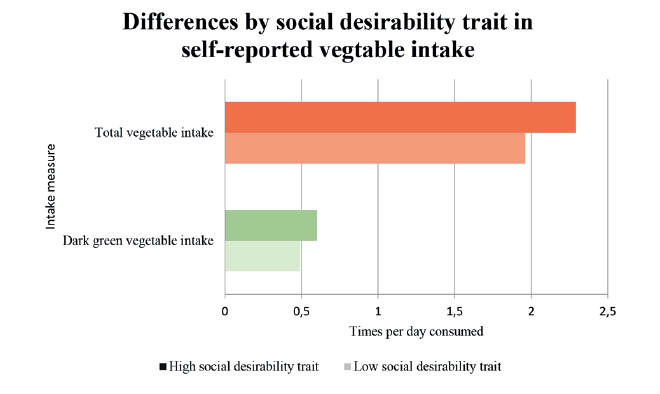Self-reported vegetable intake among WIC-enrolled women: Associations with social desirability trait
Previous work has shown that self-reported dietary behavior is susceptible to social desirability bias, the tendency to respond in a manner consistent with expected norms1. A social desirability-related upward bias (overestimate) has been observed for self-reported intakes of foods and nutrients for which increased intake is encouraged, including fruit and vegetable (F&V) intake2. The extent to which social desirability trait biases responses to particular F&V intake measures therefore requires examination. An important first step toward making such a determination is the examination of whether social desirability trait is associated with intake estimates derived from a tool in question. Conducted in a sample of 744 women enrolled in the Special Supplemental Nutrition Program for Women, Infants, and Children (WIC), this study examined whether social desirability trait was associated with self-reports of the frequency and quantity of F&V intake, and whether associations, if found, were moderated by participant characteristics.
Design and analysis
This cross-sectional study examined baseline data from WIC Fresh Start (WFS), a randomized controlled trial of nutrition education to promote farmers’ market F&V purchases and consumption among women enrolled in WIC. Social desirability trait was assessed with a 10-item version of the Marlowe-Crowne Social Desirability Scale. Two dimensions of F&V intake were assessed: the frequency of intake (times per day F&V were consumed) and the quantity of intake (cups per day of F&V consumed). Frequency of intake was measured with the 2013 Behavioral Risk Factor Surveillance System (BRFSS) F&V module. The F&V module queries intake of the following 6 items: 100% fruit juice, fruit, cooked or canned beans, dark green vegetables, orange-colored vegetables, and other vegetables. The quantity of intake was assessed with a 2-item measure developed by the National Cancer Institute. One item each assesses the number of cups of F&V (including F&V juices) the participant consumes daily. The sample was stratified into two groups based on the median split of the distribution of social desirability scores (high and low social desirability trait, respectively), and mean differences in F&V intake by social desirability trait were examined with independent samples t tests. Linear regression analyses were used to examine the relationships between social desirability trait and composite measures of the reported frequency and quantity of F&V intake (assessed separately) as well as the reported frequency of intake of F&V items assessed by the BRFSS F&V module.
Results
As shown in the figure, differences by social desirability trait were found in times per day total vegetables and dark green vegetables were reported to have been consumed (intakes were higher in the high as compared with the low social desirability trait group). Social desirability trait was significantly associated with times per day vegetables were reported to have been consumed (ß = 0.08, p-value = 0.03) and with the BRFSS item assessing the reported frequency of dark green vegetable intake (ß = 0.08, p-value = 0.03) but was unrelated to the composite measure of times per day fruit was consumed or to measures of the quantity of F&V intake. Breastfeeding status moderated the relationship between social desirability trait and self-reported vegetable intake. Among breastfeeding women, social desirability trait was unrelated to reported intake, whereas among non-breastfeeding women, it was positively associated with intake (a 1-unit increase in the social desirability score was associated with a 0.12 increase in times per day vegetables were reported to have been consumed).
As social desirability trait increases, self-reported total and dark green vegetable intake (as measured by the BRFSS F&V module) increase In this sample of WIC participants, social desirability trait was positively associated with self-reported total vegetable intake and dark green vegetable intake as measured by the BRFSS F&V module. The associations highlight the need for further research using comparative measures of “true intake” to determine whether social desirability trait is a source of reporting error (whether persons with a high social desirability trait overestimate their intake) or an influence on intake (e.g., whether persons with a high social desirability trait consume more F&V). Research also is needed to identify factors that explain differences found by breastfeeding status in the associations between social desirability trait and self-reported vegetable intake.

Based on: Di Noia J, Cullen KW, Monica D. Social desirability trait is associated with self-reported vegetable intake among women enrolled in the Special
Supplemental Nutrition Program for Women, Infants, and Children. J Acad Nutr Diet. 2016;116:1942-1950.
References
- Hebert JR, Ma Y, Clemow L, et al. Gender differences in social desirability and social approval bias in dietary self-report. Am J Epidemiol. 1997;146(12):1046-1055.
- Hebert JR, Hurley TG, Peterson KE, et al. Social desirability trait influences on selfreported dietary measures among diverse participants in a multicenter multiple risk factor trial. J Nutr. 2008;138:226S-234S.
